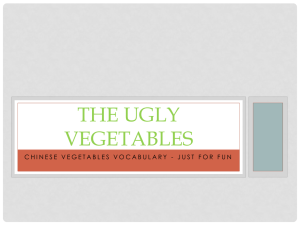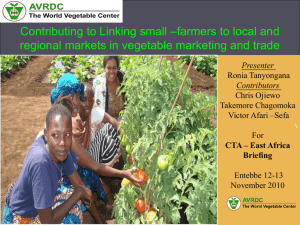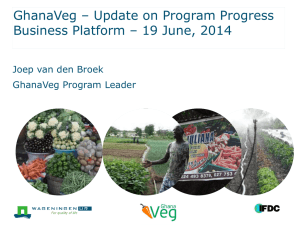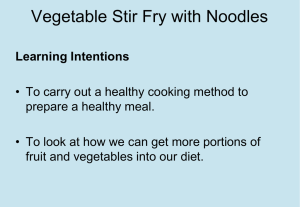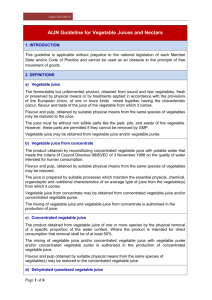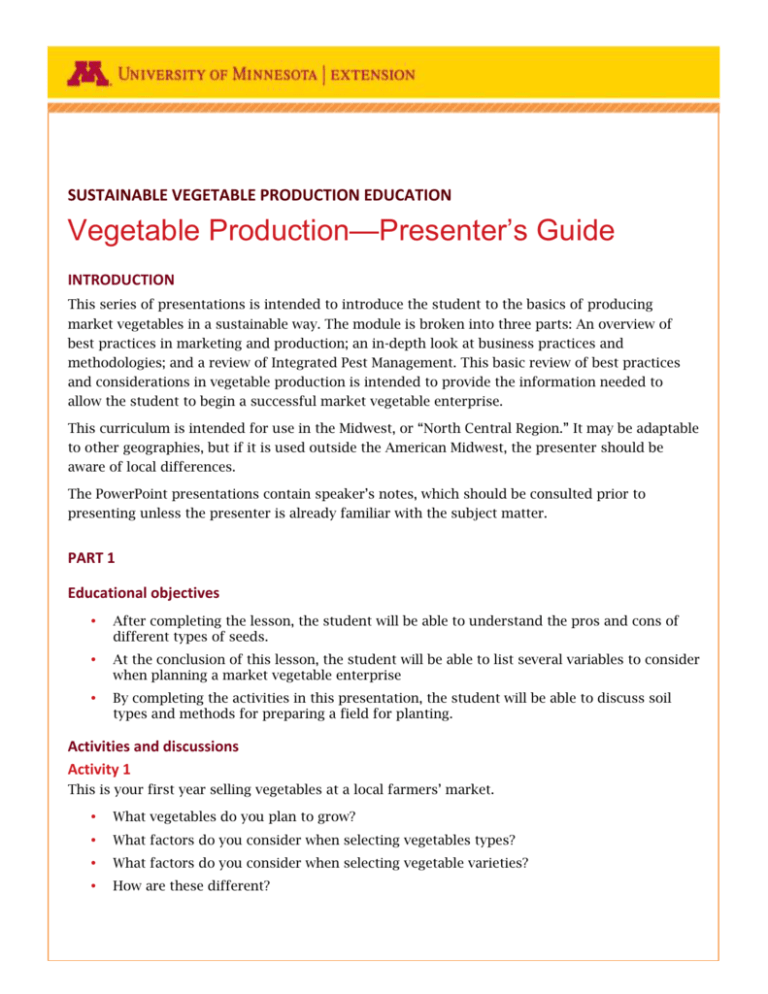
SUSTAINABLE VEGETABLE PRODUCTION EDUCATION
Vegetable Production—Presenter’s Guide
INTRODUCTION
This series of presentations is intended to introduce the student to the basics of producing
market vegetables in a sustainable way. The module is broken into three parts: An overview of
best practices in marketing and production; an in-depth look at business practices and
methodologies; and a review of Integrated Pest Management. This basic review of best practices
and considerations in vegetable production is intended to provide the information needed to
allow the student to begin a successful market vegetable enterprise.
This curriculum is intended for use in the Midwest, or “North Central Region.” It may be adaptable
to other geographies, but if it is used outside the American Midwest, the presenter should be
aware of local differences.
The PowerPoint presentations contain speaker’s notes, which should be consulted prior to
presenting unless the presenter is already familiar with the subject matter.
PART 1
Educational objectives
After completing the lesson, the student will be able to understand the pros and cons of
different types of seeds.
At the conclusion of this lesson, the student will be able to list several variables to consider
when planning a market vegetable enterprise
By completing the activities in this presentation, the student will be able to discuss soil
types and methods for preparing a field for planting.
Activities and discussions
Activity 1
This is your first year selling vegetables at a local farmers’ market.
What vegetables do you plan to grow?
What factors do you consider when selecting vegetables types?
What factors do you consider when selecting vegetable varieties?
How are these different?
Notes:
Divide class into several groups so students can share information and provide input for
each other.
Provide vegetable seed catalogs for students to look through to help them make their
selections. Be sure to include organic, OP, heirloom and hybridized seed choices.
Activity 2
You have a new field in which you plan to grow vegetables.
What do you do to prepare this field for production?
You have a soil pH of 6.5. What vegetables would work best in this type of soil?
Notes:
Divide class into several groups so students can share information and provide input for
each other.
Use a Vegetable pH preference chart to assist students in selecting vegetables for this
activity. Use one from your state, or select one of these:
o
http://www.agiweb.org/education/aapg/invest/PreferencesforpH.pdf or
o
http://www.wvu.edu/~agexten/hortcult/homegard/pHpref.pdf
PART 2
Educational objectives
Using the resources within this lesson, the student will be able to outline a basic business
plan for their operation.
At the conclusion of this lesson, the student will be able to identify local markets and make
a basic marketing plan for their operation.
By completing the activities in this presentation, the student will be able to analyze limiting
factors that will affect their operation and discuss growing methodologies that will address
these limiting factors.
Activities and discussions
Do you have a business plan in place? If not, take 15 minutes to write a short outline of
your business plan including goals for a season.
Share your plan with a partner and get their input.
Are goals realistic?
What areas need more attention?
What resources do you have currently, and what resources do you still need to research?
PART 3
Educational objectives
Using the resources within this lesson, the student will be able to outline the Essential
steps to Integrated Pest Management in Vegetable production
At the conclusion of this lesson, the student will be able to list the steps required for IPM
and how they fit with various approaches to vegetable production
By completing the activities in this presentation, the student will be able to develop a basic
IPM plan for use in their vegetable production operation.
RESOURCES
Bachman, Janet & Earles, Richard. Post-Harvest Handling of Fruits and Vegetables.
Fayetteville, AR. Appropriate Technology Transfer for Rural Areas. 2000
Berton, Valerie, ed. The New American Farmer. 2nd ed. Beltsville, MD: Sustainable
Agriculture Network, 2005.
Brandenburger, Lynn, Warren Roberts, Hailin Zhang. Soil Test Interpretations for Vegetable
Crops. Stillwater, Ok.
DiGiacomo, Gigi, Robert King, and Dale Nordquist. Building a Sustainable Business. College
Park, MD: Sustainable Agriculture Research and Education, 2003. Print. Handbook Ser. Book
6.
Diver, Steve. Resource Guide to Organic & Sustainable Vegetable Production. N.p.:
Appropriate Technology Transfer for Rural Areas, 2001. National Sustainable Agriculture
Information Service. National Center for Appropriate Technology, Sept. 2001. Web. Jan.
2010. Print
Egel, Dan. Midwest Vegetable Production Guide for Commercial Growers. West Lafayette, IN:
Purdue University, 2013.
Grimsbo Jewett, Jane, Beth Nelson, and Derrick Braaten. Marketing Local Food. St. Paul, MN:
Minnesota Institute for Sustainable Agriculture, 2007. Print
Grubinger, Vernon P. Sustainable Vegetable Production from Start-up to Market. Ithaca, NY:
Natural Resource, Agriculture and Engineering Service, 1999. Print.
Hendrickson, John. Grower to Grower: Creating a Livelihood on a Fresh Market Vegetable
Farm. Madison, WI: Center for Integrated Agricultural Systems, 2005. Print.
Li, Changying, Precooling Fruits and Vegetables in Georgia. Athens, Georgia. University of
Georgia Cooperative Extension. 2011
Maynard, Donald N., and George J. Hochmuth. Knott's Handbook for Vegetable Growers. 5th
ed. New York, NY: John Wiley, 2007. Print.
Salatin, Joel. You Can Farm: The Entrepreneur's Guide to Start and Succeed in a Farm
Enterprise. Swoope, VA: Polyface, 1998. Print.
Salatin, Joel. Family Friendly Farming: A Multi-generational Home-based Business
Testament. Swoope, VA: Polyface, 2001. Print.
Simonne, E. (2003). Drip irrigation: the BMP era: An integrated approach to water and
fertilizer management for vegetables grown with plasticulture. Gainesville, Fla.: University
of Florida Cooperative Extension Service, Institute of Food and Agricultural Sciences, EDIS.
University of Minnesota Extension, ed. Minnesota Fruit & Vegetable Growers Manual for the
Beginning Grower. Ham Lake, MN: Minnesota Fruit and Vegetable Growers Association,
2004. Print.
http://www.sare.org/Learning-Center/Books/Managing-Cover-Crops-Profitably-3rdEdition/Text-Version/Crop-Rotation-with-Cover-Crops
Midwest Vegetable Production Guide for Commercial Growers, Purdue
http://www.btny.purdue.edu/pubs/id/id-56/ID-56.pdf
http://www.lsuagcenter.com/en/lawn_garden/home_gardening/vegetables/Expected+Vege
table+Garden+Yields.htm
Local farmers market boards, State Farmers Market Association http://mfma.org/
Local SFA chapters http://www.sfa-mn.org/
Minnesota Fruit and Vegetable Growers Association (MFVGA) http://www.mfvga.org/
Minnesota Institute for Sustainable Agriculture (MISA) http://www.misa.umn.edu/
Midwest Organic Sustainable Education Service (MOSES) http://www.mosesorganic.org/
Minnesota Grown: Minnesota Department of Agriculture (MDA)
http://www3.mda.state.mn.us/mngrown/
http://www.roxburyfarm.com/
http://www.epa.gov/opp00001/science/databases_pg.htm
http://safety.cfans.umn.edu/
http://harnerbrotherscsa.com/
http://corn.agronomy.wisc.edu/Management/pdfs/IPMManual_7_WeedGuide.pdf
http://www.iowaproduce.org/pages/production/files/high_tunnel/iowa_tunnel_guide.pdf
This product was developed with support from the Sustainable Agriculture Research and Education (SARE) program, which is funded by the U.S.
Department of Agriculture — National Institute of Food and Agriculture (USDA-NIFA). Any opinions, findings, conclusions or recommendations expressed
within do not necessarily reflect the view of the SARE program or the U.S. Department of Agriculture. USDA is an equal opportunity provider and employer.
© 2014 Regents of the University of Minnesota. All rights reserved. University of Minnesota Extension is an equal opportunity educator and employer.
In accordance with the Americans with Disabilities Act, this material is available in alternative formats upon request. Direct requests to efans@umn.edu.
Printed on recycled and recyclable paper with at least 10 percent postconsumer waste material.



